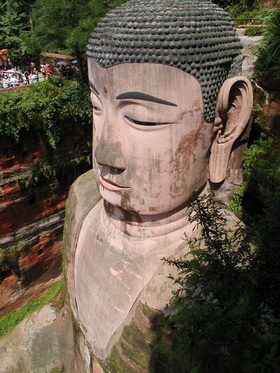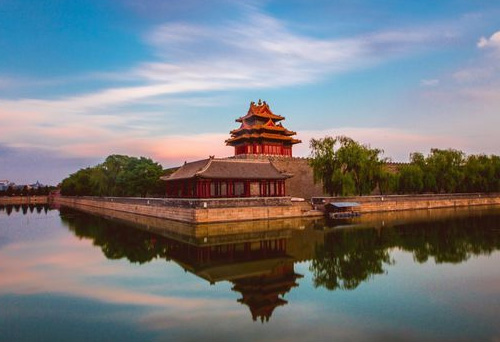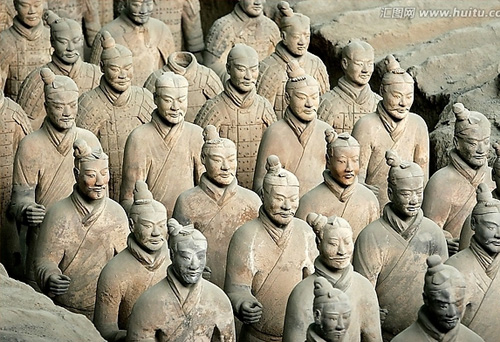Giant Buddha of Leshan
Giant Buddha of Leshan
The Giant Buddha of Leshan (aka Dafo) is the tallest stone Buddha statue in the world. It was carved out of a cliff face by an 8th-century monk in southern Sichuan province, near the city of Leshan. The Giant Buddha lies at the confluence of the Minjiang, Dadu and Qingyi rivers. It faces the sacred Mount Emei (with which it shares its World Heritage status), with the rivers flowing below his feet.
Construction on the Giant Buddha began in 713 AD. It was the idea of a Chinese monk named Haitong, who hoped that  the Buddha would calm the turbulent waters that plagued the shipping vessels travelling down the river. When funding for the project was threatened, he is said to have gouged out his own eyes to show his piety and sincerity. The massive construction project was finally completed by his disciples 90 years later. The construction resulted in so much stone being removed from the cliff face and deposited into the river below that the currents were altered by the statue, making the waters safe for passing ships as the monk had hoped. There are still some vicious currents where the three rivers meet - but none that threaten the tourist ferries.
the Buddha would calm the turbulent waters that plagued the shipping vessels travelling down the river. When funding for the project was threatened, he is said to have gouged out his own eyes to show his piety and sincerity. The massive construction project was finally completed by his disciples 90 years later. The construction resulted in so much stone being removed from the cliff face and deposited into the river below that the currents were altered by the statue, making the waters safe for passing ships as the monk had hoped. There are still some vicious currents where the three rivers meet - but none that threaten the tourist ferries.
The statue depicts a seated Maitreya Buddha with his hands resting on his knees. Maitreya is the future Buddha, who will appear to preach the dharma when the teachings of Gautama Buddha have faded away. He was especially popular during the 4th to 7th centuries, and his images are found throughout the Buddhist world, conveying his characteristic air of expectancy and promise.
The Giant Buddha of Leshan sits impassively against the mountain, hands on his knees and looking across the river with heavy-lidded eyes. Standing 71 meters (233 feet) tall, the Giant Buddha of Leshan is taller by 17 meters than the standing Buddha in Afghanistan, making it the tallest in the world. His shoulders are 28 meters (92 feet) wide and his smallest toenail can accommodate a seated person. Each eyebrow is 18 feet long. According to a local saying, "The mountain is a Buddha and the Buddha is a mountain." Several drainage passages are hidden in the Buddha's hair, collar, chest, and holes in the back of his ears and chest, preventing the Buddha from serious erosion and weathering. He has been lovingly maintained on a regular basis throughout his 1,200-year history, but is still a bit mossy.
Visitors stare in awe at the Buddha from passing tourist ferries and from a terrace next to his ear. On one side of the terrace is a modern statue of the monk Haitong, and behind is the Lingyun Temple Museum with accounts of the construction and renovations of Dafo. Also in Leshan, south of the Giant Buddha, is Wuyou Si, a pink-walled monastery founded in 742 AD. It has impressive decorations, including splendid gate guardians, animated scenes from the Journey to the West (on the second hall) and amusing sculptures of arhats (inside the Louhan Hall).
Entrance fee: RMB70/p.p
How to get:
Expressways linking Leshan to Chengdu and Chongqing; another is being built to Yibin.
There are three bus stations in Leshan. The main one for travellers is the Lehsan long distance bus station, annoyingly located in the western reaches of the city though coming in you may be dropped at any of them. Another is in the northern reaches of town.
For Chengdu, the third one, the bus station next to the Leshan docks in the most vonvenient. Buses leave for Chengdu's Xinnanmen bus station every hour. There are also frequent departures to Emei town from here. For all other destinations you will have to go to the long-distance bus stations.









